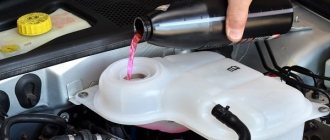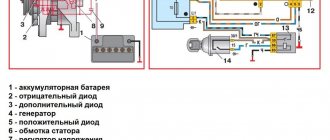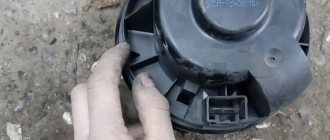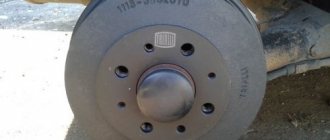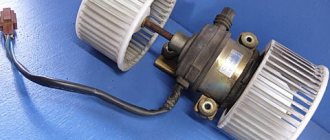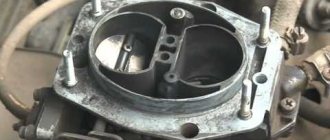When using a car for a long time, sooner or later the time comes when the driver begins to notice that the car is “pulling” worse and worse. To put it another way, the motor does not cope well even with small loads. To overcome them, you have to spin the crankshaft almost to maximum speed. Other signs also appear: sluggish acceleration from a standstill, difficulties in gaining speed when overtaking, etc. In this case, increased exhaust smoke may be observed, but there are no extraneous noises under the hood when the power plant is operating - it runs smoothly and calmly. So what happened, why doesn’t the car pull?
When the engine doesn't pull well uphill...
Poor quality fuel
In approximately 50% of cases, the “culprit” for loss of traction is fuel. Due to its poor quality or inappropriate octane number (OCN), the engine does not develop power.
You can determine that there is inappropriate fuel in a car tank based on a number of signs:
- The engine started getting worse.
- There was detonation. This symptom manifests itself most clearly if fuel with the required octane number is diluted with gasoline with a lower octane rating.
- When examining spark plugs removed from the cylinder block (BC), you can see black or reddish (brick) carbon deposits, which are uncharacteristic of serviceable parts, which indicates the presence of unnecessary impurities. The first option indicates that gasoline does not burn completely, the second confirms the presence of additives containing metal.
- Ineffective spark plugs. This can be determined during a sharp increase in speed, when the engine has no reserve for further acceleration. The spark plugs may be clogged due to low-quality fuel or may simply have exhausted their service life.
Solving the problem is not difficult: the low-quality fuel should be drained and the tank filled with suitable fuel with the required octane rating. Clean the spark plugs from carbon deposits, and if their service life has come to an end, replace them with new ones, all at once, in a set from one manufacturer. When carbon deposits appear, you will again have to start diagnosing the cylinder-piston group (CPG) and (or) the fuel system.
It is better to refuel at proven gas stations
What's the result?
With that said, if the engine is not making power, it could be due to the ignition, air or fuel supply. We add that a decrease in engine power can also occur depending on external conditions: ambient temperature and atmospheric air pressure.
If the car pulls worse under certain conditions, then this is not a malfunction. For example, high in the mountains, the power of an engine, especially an atmospheric one, decreases. Also in the summer, in extreme heat, the fuel pump or carburetor may overheat.
As a result, I would like to remind you that the throughput of the intake and fuel system greatly depends on the condition of the fuel and air filters. For this reason, filter elements must be changed promptly to ensure maximum performance from the engine.
Dirty air and fuel filters
If the first of them is clogged and does not allow air to pass through well, the mixture will be excessively rich, that is, it will contain a lot of fuel, which will no longer burn completely. As a result, engine thrust will drop. If the fuel filter is dirty, the result in terms of the operation of the power unit will be the same, with the only difference being that the mixture will become very lean, because there will be little gasoline in it. Contamination of the air filter ahead of schedule can be caused by operating the machine in dusty conditions, and the fuel filter can be caused by low quality fuel.
Reasons for loss of power in a carburetor engine
Here it is worth immediately checking the fuel level and the operation of the fuel pump: “underfilling” of fuel immediately reveals itself under load as a loss in dynamics, shooting into the carburetor. Overfilling due to a faulty carburetor shut-off needle will also lead to a loss of engine power, here black smoke and firing from the muffler will become a characteristic sign.
The car's dynamics are perceived better when accelerating, so a defect in the accelerator pump may also be a possible reason for the car's “dullness.” The fact is that all carburetor systems are designed to operate in static modes; as the speed increases, the mixture becomes leaner. The accelerator pump is used to combat this over-depletion: when you press the gas pedal, the diaphragm pushes a dose of gasoline through the shut-off valve into the nozzles that exit into the diffusers. If the diaphragm of the accelerator pump ruptures or the nozzles become clogged, the acceleration of the car will immediately deteriorate so much that it is difficult not to notice. It’s not difficult to check the accelerator pump - after removing the air filter or “turtle” from the carburetor, you need to sharply press the throttle valve drive: your fingers will feel resistance (the diaphragm will create pressure in the accelerator pump), and streams of gasoline should hit the inlet from the nozzles.
Violation of valve timing
The main parts of the gas distribution mechanism (GRM) are the intake and exhaust valves. They are “obliged” to open and close only at the right moment so that the fuel mixture enters the cylinders on time and exhaust gases are removed. This process is called phase distribution. If it is violated, you will see that the power of the engine has disappeared, which will begin to “triple” and sometimes have difficulty starting.
Causes of valve timing violations:
- wear, as well as incorrect installation, displacement of the chain or timing belt (most often this is a jump by one tooth (link));
- play or deformation of the pulley on the crankshaft;
- wear of hydraulic compensators, camshaft and (or) its bed;
- burnout or rupture of the head gasket;
- Malfunction of the camshaft position sensor (DPRV).
To restore normal operation of the timing belt, it is necessary to set the position of the timing and crankshaft shafts according to the marks. If the chain is worn, replace it. The same applies to the camshaft with a bed, hydraulic compensators, gasket and DPRV.
Fuel system malfunctions
When there is a problem with the power supply system of a gasoline engine, the loss of power is felt first. These include clogged fuel filters, interruptions in the operation of the fuel pump, power supply to the injectors, and depressurization of the fuel line, due to which the engine experiences a lack of fuel. In diesel engines, the most common problems with fuel equipment are wear of the injectors and fuel pump, depressurization of the fuel line, freezing of fuel in the fuel line and clogged filters.
Exhaust system resistance
Many people consider the only task of the exhaust system to be to muffle loud sounds and remove exhaust gases. However, modern cars are equipped with a catalyst that reduces the level of emissions of harmful substances. If this element is heavily contaminated or destroyed, the passage of gases becomes difficult. As a result, the engine works “as if strangled.”
In Russia, the problem is solved by simply removing the catalyst. However, you need to remember that in some car models such an operation will require changes in electronics (programming).
Removing the catalyst
Violation of ignition timing angles
We are talking about the moment of ignition of the combustible mixture. It is this that is determined by the ignition timing angle (IAF). When it is deviated toward increase, the mixture ignites early, and toward decrease, it ignites late. Both options lead to improper engine operation and incomplete combustion of the mixture, which may be accompanied by popping noises in the muffler. On injection engines VAZ 2110, 211, 212, 214, 215 (there are also classics with an injector, for example, VAZ 2107), the OZ is set automatically, on carburetor VAZ 2101-2106, 07, 08, 09 (the last two models can be with an injector) it must be installed manually.
Signs of violation of OZ:
- difficult engine start;
- increased fuel and oil consumption;
- drop in throttle response and power of the power unit;
- unstable operation of the internal combustion engine at idle;
- The car does not respond well when you press the gas pedal.
The engine stopped “pulling”: reasons
Has the car lost its former traction, losing power? There are many reasons for this. The engine does not lose traction/power out of the blue. The most common reason for a drop in engine power is poor fuel that you may have filled. But loss of traction can also indicate more serious problems, such as engine wear.
We at 1Gai.Ru decided to tell you about the most common causes of loss of engine power, how to look for the problem and what costs await you in order to return your car to its former lightness.
- Problem with the fuel injection system: common cause of loss of power + black smoke
- Reducing engine power is usually a task for an auto mechanic, but there are situations when even the toughest specialist cannot determine the cause
First, an important disclaimer: a drop in engine power and an uneven drop in power are not the same thing. At least for a car mechanic. Therefore, if you decide to contact a technical center to diagnose a problem, be sure to describe to the auto mechanic all the details of the behavior of your car.
For example, your car may start out moving normally and then suddenly lose power. Usually in this case the car stops responding to the gas pedal. “Check Engine” indicator will pop up on the dashboard , and smoke of an “unhealthy” color may begin to come out of the exhaust pipe.
The car may also begin to “choke” , stop, or even refuse to go any further. Even an amateur, a novice driver, should notice this phenomenon. With these symptoms, one thing is clear: there is a problem in the car. So in this case, the next step is to visit a car repair shop.
The truth is, there are many reasons for such capricious behavior of a car: starting from the failure of one of the sensors (for example, the position of the camshaft in a gasoline engine), problems in the intake manifold (turbo engines) to the failure of the turbocharger. In most cases, such signs of vehicle behavior indicate that the engine control unit has entered emergency mode in order to prevent damage to the power unit. Usually the control unit limits engine speed .
It's another matter when the engine power in your car decreases slowly and gradually . Unfortunately, if you don't drive your car often or don't use your car's engine to its full potential, it's much harder to spot the problem and signs of trouble. In this case, you most likely will not receive a warning on the device, as in the example above.
Usually, with a gradual loss of power, the car seems to be driving normally, but somehow... reluctantly . An experienced driver may notice that the car seems to be held by someone from behind (the feeling that a heavy trailer has been attached). By the way, some indirect evidence may also be a gradual increase in fuel consumption.
There can also be a lot of reasons for such a loss of traction: from the intake manifold clogged with carbon deposits (carbon deposits in the engine) and the lambda probe to wear of injectors, piston rings, pistons, valves and cylinder block.
However, there are elements in the car that, at the initial stage of wear, only slightly reduce power. This prevents the problem from being detected in time. As a result, such a component may fail unexpectedly for the driver .
For example, a slightly dirty lambda probe can slightly steal power from the car. But at some point it will throw a white flag, stopping to work completely, with all that follows: the control unit will stop receiving information about the level of oxygen in the exhaust gases , as a result of which the fuel-air mixture will be incorrect, which will lead to improper ignition of the fuel. The result is a loss of power and increased fuel consumption + a “Check Engine” indication on the dashboard, since the engine control unit will turn on emergency mode.
A separate problem is the low quality of fuel. This is the most common problem in Russia, where low-quality fuel is still not uncommon at gas stations. Even at chain gas stations that belong to major brands. If you fill your car with low quality fuel, the reduction in power will be proportional to the engine power ( the larger the volume and power of the engine, the greater the losses will be ). This applies to both petrol and diesel engines. Moreover, low-quality fuel filled at a gas station will certainly have a negative impact on the main components of the engine, accelerating their wear. And quite quickly.
But how can you check if your car has lost power? Or is this all your imagination and subjective feelings? In this case, you have a direct route to the technical center, where there is a special stand that measures the power of cars . Naturally, unless, of course, we are talking about a situation where something is clearly broken and the car has a problem starting, in which case measuring power is completely pointless.
It’s another matter when it just seems to you that your car has somewhere lost its former agility and lightness . If you use the car and its power/torque potential frequently, then you may notice a gradual loss of traction. In this case, measuring power on a stand can confirm or dispel your suspicions.
By the way, there is good news: an experienced auto mechanic will be able to correctly determine the cause of the loss of power . Moreover, based only on computer diagnostics of your car.
Below we have compiled for you a collection of possible faults that most often lead to a decrease in engine power.
Adjusting the OZ on an injection engine
Everything here is controlled by electronics. First you need to make sure that it is functioning properly and that the throttle sensor is working properly. At idle, it should be slightly open by about 1% (if this is not the case, set up a mechanical drive), the normal voltage at its contacts is 0.45-0.55 V (the car’s bot network should produce 13-14.3 V). When you sharply press the gas pedal, the damper should open 90", and the voltage on the sensor should increase to 4.5 V. If this is not the case, you need to adjust the damper drive and check the serviceability of the sensor (TPS).
To do this:
- take the tester and place it in the voltage measurement position;
- disconnect the connector from the sensor - you will see three contacts - one goes to ground, the other to the ECU (which one is connected where, determine from the diagram);
- start the engine and check the supply voltage - it should be approximately 5 V;
- turn off the engine and switch the tester to resistance measurement mode;
- with the damper closed, between ground and the contact going to the computer, the device should show 0.8-1.2 kOhm;
- with the damper open, resistance is 2.3-2.7 kOhm.
If the received data does not correspond to the above parameters, the sensor must be replaced. If this does not work, you should check the ECU.
The main reasons for the reduction in engine power
1. Malfunction of the crankshaft position sensor
There are situations when the DCPV untimely sends a control command to supply the air-fuel mixture. As a result, the power of the power unit drops before our eyes. The main cause of the failure is the shift of the toothed star relative to the pulley and the delamination of the damper. In such a situation, it is necessary to carefully inspect the damper and replace it.
2. Increasing (decreasing) the gap between the spark plug electrodes
During operation, due to strong temperature effects, the distance between the electrodes of the spark plug may decrease or increase. To exclude or confirm your suspicion, you need to check the size of the gaps using a round feeler gauge. If the distance is less or more than acceptable, you need to make an adjustment by bending the side of the electrode or replace the spark plug. As for the optimal spark gap distance, it can be different (depending on the type of spark plug) - 0.7-1.0 mm.
The appearance of carbon deposits on the spark plugs is another clear sign of a problem.
If the engine does not pull well, you need to unscrew all the spark plugs one by one and inspect them. If obvious carbon deposits appear on the electrodes, the device must be cleaned using a brush with metal bristles. It is important not only to clean the spark plugs or replace them, but also to find out the cause of this phenomenon.
Failure of spark plugs
A decrease in engine power may be caused by product failure. In this case, it is necessary to check the performance of the spark plug on a special stand. If the suspicions are confirmed, then the only way out is to replace the set or one spark plug.
There is no gasoline in the tank
You can diagnose the problem using the fuel level indicator. If it is faulty or there is a suspicion that it is “inadequate,” then the presence of fuel can be determined by removing the fuel pump.
Fuel filter contamination, water freezing in the system, pinched fuel wire, fuel pump failure
All these malfunctions can be safely classified into one category, because they all have the same symptoms - the starter cranks the engine, but there is no smell of fuel from the exhaust pipe. If the car has a carburetor, then the reason must be sought in the float chamber. Most likely, fuel is not supplied to it. In the case of an injector, it is easier to check the presence of fuel in the ramp by pressing a special spool (installed at the end of the ramp).
To correct the problem, you need to warm up the engine thoroughly and bleed the power system with a tire pump. After this, all system pipes, hoses and the fuel pump itself are changed.
Fuel pump produces too little pressure
This problem can only be determined by special measurements (taken directly at the outlet of the fuel pump). After this, the quality of operation of the fuel pump filter is checked.
The solution is to clean the fuel pump filter, replace it (if repair is not possible) or install a new fuel pump.
Poor contact quality in the circuit
Poor contact quality in the circuit that powers the fuel pump or failure of its relay. The first thing you need to do to check is to make sure the quality of the “ground” on the car and measure the resistance using a multimeter. If the resistance level is really too high, then the only way out is to clean the contact groups, crimp the terminals well, or install a relay (if the old one is faulty).
9. Failure of injectors or malfunction in the supply system
If there is a suspicion of failure of these elements, it is necessary to check the resistance of the windings using a multimeter for a break or an interturn short circuit. If the cause of the problem is a malfunction of the computer, then such a check can only be carried out at a service station.
There are several ways to eliminate a decrease in engine power for this reason (depending on the depth of the problem) - install a new ECU, clean all injectors, ensure good contact in the electrical circuit, and so on.
DPKV failure
To solve the problem, it is enough to restore normal contact in the electrical circuit and install a new sensor (if the old one turns out to be faulty).
DTOZH is out of order
The DTOZH - the sensor that controls the temperature of the coolant - has failed. Symptoms of the malfunction are as follows: the engine malfunction lamp comes on. If there is a break, the system’s electric fan begins to rotate continuously. In addition, it is necessary to check the serviceability of the sensor itself.
Setting the OZ on carburetor engines
The simplest and most effective way is to use a regular 12-volt light bulb.
Algorithm of actions:
- Rotate the crankshaft pulley until the marks match (on the cover - this is the central mark) using a special spanner. If it is not there, turn on 4th gear and push the car until the marks match.
- From the ignition breaker (distributor), disconnect the thin wire going to the coil and attach a light bulb to it, the second contact of which is connected to ground.
- Loosen the nut securing the distributor (usually it is a “13” wrench).
- Turn on the ignition, make sure that the lamp is on, and slowly turn the distributor around its axis until it goes out.
- Now turn the distributor again until the light flashes, and immediately tighten the distributor fastening nut.
Lada 2115 15 strict mode =) › Logbook › The dynamics are gone, the car doesn’t pull, it doesn’t start well
Once again my hardware failed me. In the morning everything was fine, I went to a gas station and parked the car at the house. I start up the 3rd time and understand that it’s another surprise. I immediately heard a strange exhaust when changing the throttle, but when I drove off, I didn’t see the dumber car at all, it wasn’t driving at all, I was even afraid to move away from intersections without a traffic light, it started to heat up like crazy, the fan wouldn’t turn off at all. I filled up another 20 liters of other gasoline at another gas station, I thought it was gasoline, there was no reaction. I went to the service center where they measured the pressure and pressed it to increase the pressure in the injectors, supposedly pushing the dirt through, but to no avail. I bought the flush and poured it into the tank according to the instructions and went for a drive, barely reaching 80 by 4. In general, I gave up everything and signed up for a service that was recommended by a friend. The next day I was not happy because they said a bunch of reasons, they looked at all the injectors, changed the wires, looked at the timing belt and everything seemed to be normal, but then they noticed that the pulley was not just crooked, but was held on by one mount; the second one broke off completely in the pulley itself , accordingly, the crankshaft sensor gave incorrect data to the ECU and the car refused to move. After the replacement everything returned to normal, it drives as before)))
Malfunctioning spark plugs
The planned replacement of these elements of the ignition system is carried out after 20-30 thousand kilometers. If the spark plugs are platinum, the resource increases to 100 thousand km. However, the situation when candles (most often one of them) fail ahead of schedule is not uncommon.
This can be seen and heard by a number of signs:
- the engine starts with difficulty, especially in winter;
- idling is unstable, the tachometer needle jumps, the engine may stop periodically;
- when the power unit is operating, increased vibration is observed, for example, the gearbox shift lever shakes;
- poor acceleration dynamics - the car does not develop full power, it stalls;
- when you press the accelerator, “dips” are noticeable;
- fuel consumption has increased.
When one spark plug does not work, experienced drivers say that the engine is “troubling,” that is, only 3 out of 4 cylinders are working.
To find a faulty part, you need to:
- put on dielectric rubber gloves;
- with the engine running, disconnect the high-voltage wire from each spark plug one by one;
- in this case, the nature of the engine’s operation should change, the speed should drop, but if this does not happen, it means that the cylinder is not working - the spark plug does not produce a spark.
It is worth finding out the reason for the poor performance of the part; it is quite possible that it is defective. If other spark plugs subsequently begin to fail, you will have to look for the cause elsewhere - the CPG or the fuel system.
Fuel injection and oxygen supply
An engine that does not receive the required amount of fuel at a sufficiently high pressure cannot, of course, develop the full power provided by the automaker. If the car has a problem with the supply of fuel to the combustion chamber, then there is a malfunction in the injector. This is why it is so important to clean the injector regularly.
In diesel engines, the high pressure fuel pump most often fails. In gasoline engines, a problem with fuel supply may also be associated with a failure of the lambda probe, which measures the oxygen level in the exhaust system, reporting data to the engine control unit. In this case, the fuel injection and air-fuel mixture will be incorrect, which will lead not only to loss of power, but also to problems with engine operation. To the point of failure to start.
Compression reduction
Often, the reasons for loss of engine power can be associated with simple wear and tear of the power unit. Do not forget that a car aged about 100 thousand kilometers begins to lose its power by 10-15%. If you think the losses are excessive, you need to check the compression. Its nominal value is indicated in the documentation for the machine. For testing, you will need an inexpensive device - a compression gauge, which is a pressure gauge mounted on a hollow tube or connected to a rubber hose equipped with a tip. It is screwed into the cylinder block instead of a spark plug. Next, disconnect the high-voltage wire from the ignition coil. Crank the crankshaft with the starter and note the highest reading on the compression gauge. The operation should be repeated for each cylinder.
Compression check
Pressure below that specified in the instructions by more than 15% indicates wear of the rings, pistons, cylinder block walls, and valves. To solve the problem, you can bore the BC to the repair size, replace the piston rings, grind (or replace) the valves.
Power system pressure
The fuel pump is located in the gas tank on the injection engine. The pump will be found under the hood, on the engine. For most cars, power loss can be attributed specifically to the fuel pump.
Many modern cars have special connectors on the fuel line for connecting a pressure gauge. This way you can check the pressure. If the connector is missing, you will have to work a little to connect.
Pressure values can be found in the engine instructions. There is a special regulator in the line, with which you can relieve excess pressure directly into the tank. This regulator may be incorrectly configured, or it may leak. To check it you will need an ordinary air pump. Using it, you need to smoothly raise the pressure level to the one indicated in the passport for the motor. If you did not have time to increase the pressure, and the regulator dumped fuel into the tank, then it must be replaced.
Automatic transmission malfunctions
One of the tasks of the gearbox is to transmit torque to the wheels. And if this process is disrupted, then the engine does not gain momentum. You step on the gas and the acceleration is sluggish. The whole point may be a slipping automatic transmission.
There are several reasons for this:
- low-quality gear oil or not what the manufacturer recommends;
- clogged filters;
- clogged valve body channels;
- faulty solenoids (in this case, slipping is observed “hot”);
- wear of friction clutches (maximum service life 200-300 thousand km);
- problem with the control unit.
Most of the above faults are difficult to eliminate in a garage. Therefore, you will have to use the services of a specialized technical station.
Low quality fuel
If, in addition to loss of power, no other related problems are found, then the first thing you need to remember is at which gas station the car was refueled. According to statistics, in half of the cases the culprit for loss of power is bad fuel. The quality of the fuel directly affects the behavior of the car. You can press the accelerator pedal to the floor for as long as you like, but if the fuel is inappropriate (AI-92 instead of AI-95) or of poor quality, there will be no positive effect. Not only the driver suffers, but also the car itself: the engine “sneezes”, the speed fluctuates, the Check Engine lights up on the instrument panel. Sometimes the problem is solved by purchasing fuel at a trusted gas station and then diluting the contents of the tank with high-quality “food”. But before this, it is advisable to drain 5-10 liters of previously purchased fuel. In especially severe cases, the contents of the gas tank are completely drained, and then the power system is washed.
If the carburetor engine does not pull
A carburetor is a mechanical device for preparing a combustible mixture of fuel and air. If the proportions of the components in this mechanism are violated, then the engine does not pull.
You need to adjust the carburetor in stages:
- Jets. Check their calibration - the part supplying air must have a larger diameter than the one through which fuel is supplied.
- Throttle valve. When you press the gas, it should open completely (if this is not the case, adjust the drive).
- Ignition system. Its contact version was discussed above. To check the contactless system, turn on the ignition and look at the dashboard voltmeter - its needle will approach “12”, and after a second it will rise higher. If there is no voltmeter, install a known-good switch and check the operation of the ignition system again.
Standard carburetor
Power drop on a VAZ carburetor engine
To begin with, let's take VAZ cars with a carburetor power system and an 8-valve timing system - VAZ-2109, VAZ-2110, VAZ-2114, VAZ-2115.
The same power plant is installed on these cars, so the reasons are identical.
Let's go through those components, due to malfunction of which a drop in dynamics may occur.
In general, the main reason that the engine does not pull is a change in the processes in the combustion chambers - a mismatch in the proportions of the air-fuel mixture, the combustion process is disrupted, the filling of the cylinders and the removal of exhaust gases does not occur as required.
Supply system
Very often, a drop in traction occurs due to the power system. Structurally, the carburetor fuel system used on cars from VAZ-2109 to VAZ-2115 is very simple and is almost completely mechanical, so identifying the cause is not particularly difficult.
A decrease in power can occur due to:
- Severely clogged fuel filter (its throughput drops and the pump is simply not able to pump the required amount of fuel);
- Contamination of the carburetor channels (the jets and fuel channels in this element have a small cross-section and debris often clogs them);
- There is air leakage in the area from the tank to the pump (because of this, the performance of the fuel pump drops sharply);
- Damage to the fuel pump membrane (a small crack in it leads to the fact that the vacuum required for pumping fuel is not created in the pump chambers);
- The fastening of the carburetor or intake manifold is loose (due to this, air leaks around the carburetor and the proportion of the air-fuel mixture is greatly disturbed);
- The hole in the fuel tank cap is clogged (because of this, a vacuum is created in the tank and it is much more difficult for the gas pump to pump gasoline out of it);
In addition to the elements responsible for supplying fuel, a drop in power also occurs due to severe contamination of the air filter element.
Ignition system
This system also takes part in the combustion of the mixture, which means a failure in its operation can affect power.
In carburetor engines VAZ-2110 and others, a decrease in traction can occur due to:
- Faulty spark plugs or changes in their thermal gap;
- Excessive wear of the contacts and the central electrode of the distributor;
- Voltage losses in high-voltage wires;
- Violations of the ignition timing.
Irregularities in the power supply and ignition systems most often cause a drop in power, so testing to identify the cause should begin with them.
If the operation of these systems does not raise suspicions, other components of the engine should be diagnosed.
Exhaust system, timing belt and crankshaft
Loss of traction can also occur due to the exhaust gas removal system, although problems with it rarely occur on carburetor engines.
The main reason here is the reduction in throughput due to large deposits in the muffler. Because of this, exhaust gases, without having time to escape from the cylinders, “choke” the engine.
The reasons for the drop in thrust are also often the gas distribution mechanism and the cylinder-piston group.
Here the reduction in power occurs due to:
- Violations of the thermal clearance of valves.
- Heavy carbon deposits on the valve plates and seats, or their burning.
- Occurrence of rings.
- Limit wear of the CPG.
- Cylinder head gasket failure.
In general, problems with the timing belt and CPG cause a drop in power in any engine - carburetor, injection, diesel. Therefore, we will not mention these mechanisms further.
Why does an injection engine lose power?
The peculiarity of this engine is a fuel pump that works like an electric motor. If it does not work correctly, the engine speed will be unstable in all ranges. That is, fuel will be supplied unevenly, which will lead to a drop in the power of the power unit. The pump may not work well due to a dirty filter - it needs to be checked and cleaned if necessary. Another reason for the loss of power in an injection engine is the inefficient operation of the injectors, which become dirty during operation. You need to carry out diagnostics using a special (or even homemade) stand and clean the parts or replace them with new ones. The next reason is the incorrect operation of the electronics. These could be sensors or the ECU itself. In the latter case, it is recommended to install a working unit or go to a service station.
If you have any questions, leave them in the comments below the article. We or our visitors will be happy to answer them
Weather and nature
Rain
In the rain, aerodynamics deteriorate and rolling resistance increases. Under heavy rain, the density of the very environment through which the car is pushing becomes much higher: after all, water is 800 times denser than air. I personally witnessed how, in heavy rain, a B-class car with an 85-horsepower engine refused to go faster than 65 km/h.
Wind
If the headwind speed is 20 m/s, up to a third of the engine power (depending on the speed of the car) is spent on overcoming air resistance. And strong cross-winds worsen the dynamics - especially of crossovers and minivans, which have a large cross-sectional area.
Highlands
The higher you climb into the mountains, the more traction drops. The reason is worse filling of the cylinders due to lower air density at altitude.
Every 1000 m above sea level, about 10% of the power is taken from the naturally aspirated engine. It turns out that a 100-horsepower engine at a four-thousandth pass will produce less than 70 hp.
Modern supercharged engines perform better in the mountains because turbochargers rely on excess performance to provide a wide torque shelf. In the mountains, this shelf will shift towards higher speeds, but in power modes the engine will pull well.

